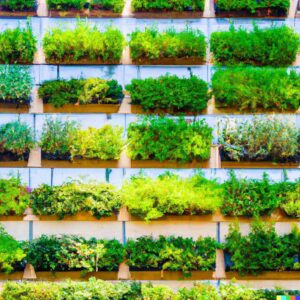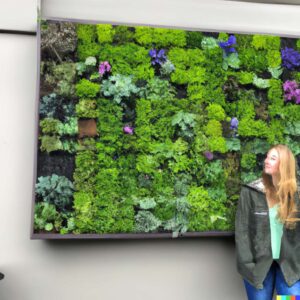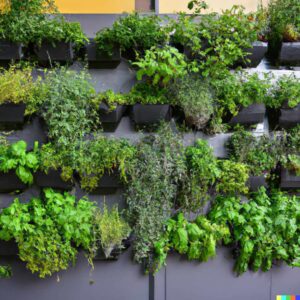Create a DIY Living Wall. A living wall, also known as a vertical garden or green wall, is a wall that’s partially or completely covered with greenery. This greenery includes a growing medium, such as soil or a substrate, and is often integrated with a water delivery system.
Living walls have become a popular trend in urban gardening, offering a unique way to bring nature into indoor and outdoor spaces. These vertical gardens not only enhance the aesthetic appeal of a space but also provide numerous environmental and health benefits. A living wall can transform any area into a lush and vibrant oasis, whether you have a small balcony or a large backyard.
Vertical gardening dates back to ancient civilizations, but it’s only in recent years that it has gained significant attention. With advancements in technology and a growing awareness of sustainable practices, living walls have emerged as a solution to urban challenges, providing beauty and functionality.
Key Takeaways
- Living walls bring nature into urban spaces.
- They offer environmental, health, and aesthetic benefits.
- Proper plant selection and maintenance are crucial for a thriving living wall.
- Living walls can be customized to fit any space and preference.
- They contribute to biodiversity and improve air quality.
How Do Living Walls Work?
Living walls are a marvel of both design and nature. Creating a living wall transforms an unused wall into a masterful botanical mosaic brimming with life. You can craft a beautiful living wall with a dash of creativity and committing to regular care. Follow these guidelines to select the ideal location, build a sturdy support structure, artfully arrange plants, and set up irrigation. Soon, you’ll have your own thriving vertical garden – an urban paradise filled with botanical wonder. Let your living wall bloom and flourish as a green entryway, soothing backdrop, or eye-catching centerpiece. They work by providing plants with a vertical space to grow rather than the traditional horizontal ground. Here’s a breakdown of how they function:
- Structure: The backbone of a living wall is its frame, which holds the plants and the growing medium. This frame can be made of various materials, including metal, wood, or plastic.
- Growing Medium: Unlike traditional gardens, living walls don’t use regular soil. Instead, they use a lightweight medium, such as felt or foam, which provides plants with the necessary nutrients without weighing down the structure.
- Irrigation: Living walls have a built-in irrigation system that delivers water to the plants. This system can be manual or automated, ensuring that plants receive the right amount of water.
- Plant Selection: The plants chosen for a living wall need to be suitable for vertical growth. They should have shallow root systems and be able to thrive with the provided nutrients.
- Orientation: The direction the living wall faces (north, south, east, or west) will determine the amount of sunlight it receives. This orientation affects the type of plants that can be used.
- Maintenance: Regular maintenance, such as pruning, watering, and checking for pests, ensures the longevity and health of the living wall.
- Environmental Benefits: Living walls act as natural air purifiers. They absorb carbon dioxide and release oxygen, improving air quality. Additionally, they provide insulation, reducing energy costs.
- Aesthetic Appeal: Beyond their functional benefits, living walls are visually stunning. They can transform a dull space into a vibrant green oasis, creating a calming and refreshing ambiance.
- Flexibility: One of the beauties of living walls is their adaptability. They can be designed for both indoor and outdoor spaces, and their size and shape can be customized to fit any area.
- Community Engagement: Living walls often become community landmarks. They promote biodiversity, attract pollinators, and provide a space for people to connect with nature in urban settings.
How to Create a DIY Living Wall System

Creating a living wall might seem like a daunting task, but with a sprinkle of patience and a dash of creativity, it can be a delightful DIY project. It will bring a touch of nature into your space and offer numerous benefits, from air purification to aesthetic appeal. Here’s a detailed step-by-step guide to help you set up your very own living wall:
a. What You Will Need:
- A sturdy frame or panel: This will serve as the base for your living wall. Ensure it’s strong enough to hold the weight of the plants and the growing medium.
- A lightweight growing medium (e.g., felt or foam): This medium will support the plants’ roots and retain moisture, ensuring they get the nutrients they need.
- Vertical planters or pockets: These containers will hold your plants. They come in various sizes and materials, so choose one that fits your design vision.
- Plants suitable for vertical growth: Think ferns, succulents, or even some herbs. Do some research or ask at your local nursery for recommendations.
- An irrigation system (manual or automated): Keeping your plants hydrated is crucial. Depending on your setup, you can opt for a simple manual watering method or an automated drip system.
- Basic gardening tools (e.g., trowel, gloves, scissors) will help you plant and maintain your living wall.
b. Choose the Right Space
i. Location Requirements:
Select a location that caters to the needs of your chosen plants. For instance, if you’re going for sun-loving plants, a spot that receives ample sunlight throughout the day would be ideal. On the other hand, shade-loving plants would prefer a more sheltered location.
ii. Display Options:
Decide on the overall look of your living wall. Do you envision a lush green indoor oasis? Or perhaps an outdoor vertical garden that becomes the focal point of your patio? Your choice will influence the type of plants and setup you’ll need.
c. Prepare the Surfaces:
Before you start, ensure the wall or frame is clean and free from any damage. If you’re setting up outdoors, check for any signs of wear and tear that might affect the stability of your living wall.
d. Fix Your Vertical Planters:
Securely attach your vertical planters or pockets to the wall or frame. It’s essential to ensure they’re evenly spaced and can hold the weight of the plants and soil.
e. Choose Your Plants:
When selecting plants, consider their growth habits, water needs, and sunlight requirements. Mixing and matching different textures and colors for a more visually appealing wall is also good.
f. Pot Your Plants:
Using your trowel, fill the planters with the growing medium. Place your plants into the medium, ensuring they’re snug but not overly compressed.
g. Place the Planted Pots in the Pockets:
Once you’ve potted all your plants, carefully insert them into the pockets of your vertical planters. This design allows for easy access when watering or tending to your plants.
h. Irrigation and Maintenance:
Watering is crucial for the well-being of your living wall. Depending on your setup, you can opt for manual watering or set up a drip irrigation system. Regularly check your plants for signs of pests or diseases, and prune any overgrown sections to maintain a neat appearance. Remember, a little love and care go a long way in ensuring your living wall thrives! 🌿
Living walls require consistent moisture. Set up an irrigation system to automatically water plants:
- Drip system – Flexible tubing with emission devices releases water slowly. Easy to install and customize.
- Hydroponic – Nutrient-rich water circulates through panels housing plants. It is more complex but conserves water.
- Manual – A simple option, especially for small walls, is hand-watering with a hose or watering can.
Include an on/off valve for easy access. Set a timer to deliver adequate water without oversaturation. Test the system and adjust as needed before planting.

Basic Maintenance of a living wall
Like any garden, a living wall requires regular care and attention to thrive. These vertical gardens, while a stunning addition to any space, have unique maintenance needs due to their structure and design. Ensuring that each plant receives the right amount of nutrients, water, and sunlight is crucial. Additionally, monitoring for signs of disease or pests that could quickly spread across the wall is essential because the plants are closely packed together.
- Watering: Ensure your plants receive the right amount of water. Overwatering can lead to root rot, while underwatering can cause plants to wilt. An automated irrigation system can help regulate water levels.
- Pruning: Regularly trim overgrown plants to maintain the wall’s aesthetics and health. This also encourages new growth.
- Pest Control: Check your living wall for pests like aphids or spider mites. Use natural repellents or organic pesticides to keep them at bay.
- Fertilizing: Feed your plants with organic fertilizers to ensure they get the necessary nutrients. However, avoid over-fertilizing, as it can harm the plants.
- Plant Replacement: If you notice a plant isn’t thriving, consider replacing it. This ensures the overall health and appearance of the living wall.
- Cleaning: Dust and debris can accumulate on the wall. Gently clean the surfaces and the spaces between plants to keep the wall looking fresh.
While living walls are a testament to the beauty of nature and human ingenuity, they are not without their challenges. Regular maintenance ensures that this beautiful blend of art and nature remains vibrant and healthy for years to come. With dedication and love, your living wall will beautify your space and provide a serene and calming environment. 🌿 We also have a full guide on living wall maintenance.
What are the benefits of Creating a Living Wall?
Beyond their undeniable aesthetic appeal, living walls offer many benefits that can enhance both our living spaces and our well-being. Here’s a closer look at some of these advantages:
Decorative disguise
Living walls can transform bland walls or unsightly areas into vibrant, green masterpieces. They can be used to cover up imperfections or simply to add a touch of nature to urban settings.
Insulation
These vertical gardens provide natural insulation, helping to regulate the temperature inside buildings. During summers, they can cool down interiors; in winter, they act as a buffer, retaining warmth.
Biodiversity
By introducing a variety of plants, living walls can attract beneficial insects and birds, promoting biodiversity even in urban areas.
Privacy
Strategically placed, living walls can act as natural screens, offering privacy from prying eyes or busy streets.
Soundproofing
Plants can absorb sounds, making living walls an excellent solution for reducing noise pollution in bustling urban environments.
Air purifying
Plants are nature’s air purifiers. They absorb carbon dioxide and release oxygen, improving air quality. Additionally, they can filter out harmful pollutants, ensuring cleaner air for inhabitants.
Living walls are not just a trend but a sustainable solution for modern architectural and environmental challenges. By integrating nature into our daily lives, they remind us of the delicate balance between urbanization and ecology.
How Does a Faux Vertical Garden Wall Compare to a DIY Living Wall in Terms of Maintenance and Longevity?
When comparing a faux vertical garden wall to a DIY living wall in terms of maintenance and longevity, the faux option offers a low-maintenance solution with no need for watering or pruning. On the other hand, a DIY living wall requires regular care and maintenance to ensure its longevity and health. If you want to transform your space faux vertical garden may be the better option for you.
What Plants are Best for Living Walls?
Choosing Plants 🌱🌷🌺
When selecting plants, opt for varieties that:
- Have shallow root systems – Avoid plants with invasive roots that could damage your wall.
- Require little pruning – Minimize maintenance with slow-growing, compact varieties.
- Tolerate drought – Wall plants dry out faster, so pick drought-resistant species.
- Suit your light conditions – Match plants to the wall’s sun exposure.
- Provide visual interest – Vary textures, leaf shapes, and colors for added flair.
Some great options include:
| Plants | Details |
|---|---|
| Succulents | Low-maintenance, drought-hardy plants with sculptural shapes. |
| Spider plants | Form clumps of arching leaves with pups that can be replanted. |
| Ivy | Trailing vines that climb walls without attaching. |
| Herbs | Add edible plants like mint, thyme, oregano or basil. |
| Ferns | Feathery foliage thrives in shady spots. |
| Bromeliads | Tropical plants with vivid, banded leaves. |
| Mosses | Low-maintenance background carpets |
Arranging Plants Creatively 🎨
When you Create a DIY Living Wall, consider the overall aesthetic:
- Place larger, eye-catching plants towards the center and bottom.
- Use vines and trailing plants along the edges to soften the look.
- Alternate leaf shapes and textures for visual depth.
- Repeat colors throughout for a cohesive effect.
- Leave some negative space instead of cramming in plants.
Let your imagination run wild – you can always rearrange plants later as your green wall evolves.

Shade Seeking Plants for Living Walls
- Pachysandra: This evergreen ground cover thrives in shaded areas, providing a lush green backdrop throughout the year. It’s low-maintenance and spreads quickly, making it a popular choice for gardeners.
- Heuchera: With its vibrant foliage that ranges from deep purple to lime green, Heuchera adds visual interest to any garden. It’s perennial, meaning it’ll grace your wall with its beauty year after year.
- Vinca Minor: This plant boasts glossy leaves and delicate blue flowers. It’s a hardy ground cover perfect for areas with partial to full shade.
- Ferns: These ancient plants bring a touch of wilderness to your garden. They thrive in moist, shaded areas and come in various species, each with its unique appearance.
- Hostas: Their broad, variegated leaves are a favorite for shaded gardens. They produce tall flower spikes in summer, adding height to your living wall.
- Ivy: A classic choice for walls, ivy is known for its fast growth and ability to thrive in shade. Its evergreen nature ensures greenery throughout the year.
- Bleeding Heart: This plant gets its name from its unique heart-shaped flowers. It’s a spring perennial that loves the shade and adds a romantic touch to any garden.
Sun Loving Plants for Living Walls
- Erigeron: With its daisy-like flowers, Erigeron is both hardy and drought-resistant. It’s perfect for sunny spots and blooms throughout the summer.
- Pelargoniums (Geraniums): These plants are known for their colorful blooms and fragrant leaves. They’re ideal for walls with ample sunlight and various species and colors.
- Gaillardia: Also known as blanket flowers, Gaillardia sports bright red and yellow flowers. It’s a sun-lover that’s both drought-tolerant and long-blooming.
- Succulents: These plants store water in their leaves, making them perfect for sunny and dry locations. They come in various shapes, colors, and sizes, adding texture and interest to your wall.
- Lavender: Known for its fragrant purple flowers, lavender is both decorative and useful. It’s drought-resistant and attracts beneficial pollinators like bees and butterflies.
- Sedum: This hardy plant boasts star-shaped flowers and fleshy leaves. It’s drought-tolerant and perfect for sunny locations.
- Marigolds: With their bright orange or yellow flowers, marigolds are sun-loving plants that also repel pests.
The Best Edible Plants for Living Walls
- Thyme: A fragrant herb that’s both culinary-friendly and decorative. Thyme thrives in sunny spots and its tiny flowers attract pollinators. It’s versatile in cooking, adding flavor to various dishes.
- Marjoram: A relative of oregano, marjoram has a sweeter and milder flavor. It produces small white or pink flowers and prefers sunny locations. It’s a favorite in Mediterranean cuisine.
- Strawberries: These delicious fruits are not only tasty but also decorative. They produce white flowers before bearing fruit and prefer well-drained soil. Imagine plucking fresh strawberries right from your wall!
- Basil: A favorite among herb enthusiasts, basil loves sunlight. It’s known for its aromatic leaves, a staple in Italian cuisine. Plus, it flowers in late summer, attracting bees.
- Mint: Refreshing and easy to grow, mint spreads quickly and can be invasive. It’s best contained in pockets or pots. Its aromatic leaves can be used in teas, desserts, and more.
- Chives: These onion-flavored herbs produce beautiful purple flowers. They’re perennial, returning year after year, and their green stalks are perfect for garnishing dishes.
- Parsley: A versatile herb with curly or flat leaves. It’s used in various dishes for its fresh flavor. Besides culinary uses, its vibrant green leaves add texture to living walls.
Climbers for Creating Living Walls
- Hops: Known for their unique appearance and association with beer-making, hops are fast-growing climbers. They produce cone-like structures and thrive in sunny to partially shaded areas.
- Laburnum: This plant is admired for its cascading yellow flowers. It’s a deciduous tree that can be trained to climb walls. However, it’s worth noting that all parts of the plant are toxic if ingested.
- Honeysuckle: Its fragrant flowers attract pollinators like hummingbirds and bees. It’s a vigorous climber that blooms from spring to fall.
- Clematis: This plant is known for its large and colorful flowers. It’s a popular choice for vertical gardens and comes in various species, each with its unique bloom color.
- Jasmine: Producing white, fragrant flowers that bloom in the evening, jasmine is a favorite for many gardeners. It’s a twining climber that prefers sunny to partially shaded spots.
- Wisteria: With its hanging clusters of purple or white flowers, wisteria is a sight to behold. It’s a vigorous climber that requires sturdy support.
- Passionflower: Known for its exotic-looking flowers, passionflower can also produce edible passion fruits. It’s a fast-growing climber that loves the sun.
Conclusion
To Create a DIY Living Wall is to take a journey that brings together creativity, nature, and a touch of magic. It’s a testament to the wonders of the natural world and our innate desire to connect with it. From the initial planning stages to watching the first blooms open, every step is filled with discovery and joy.
is to take a journey that brings together creativity, nature, and a touch of magic. It’s a testament to the wonders of the natural world and our innate desire to connect with it. From the initial planning stages to watching the first blooms open, every step is filled with discovery and joy.
Living walls are more than just vertical gardens; they are living artworks that evolve with time. They breathe life into spaces, transforming them into vibrant sanctuaries with color and life. Whether you’re an urban dweller looking to bring a slice of nature into your apartment or someone with a sprawling garden, a living wall adds a unique dimension to your space.
But beyond the aesthetics, living walls are a statement of sustainability and eco-consciousness. In a world grappling with environmental challenges, every plant we nurture is a step towards a greener, healthier planet.
So, as you embark on this gardening adventure, remember that you’re not just creating a wall; you’re crafting a living tapestry, a story of nature and nurture. Embrace the process, cherish the challenges, and let your living wall be a testament to the beauty of nature and the boundless possibilities it holds.
Thank you for joining me on this journey, dear gardener. May your living wall thrive and bring joy to all who behold it. 🍃

